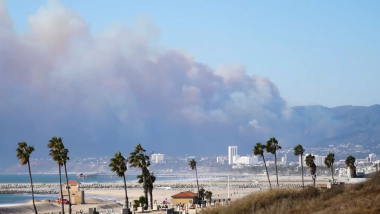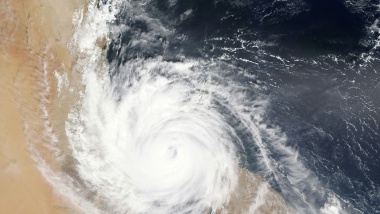COP27: Key messages and implications for insurers
By Maryam Golnaraghi
Director Climate Change and Environment
The 27th Conference of the Parties (COP27), convened by the United Nations and held in Sharm El-Sheikh in November 2022, brought together a record number of leaders and experts from the public and private sectors to discuss innovative solutions and forge new partnerships to combat climate change.[1] In parallel, at the G20 summit in Indonesia, Presidents Biden and Xi Jinping met and renewed their commitment to working together to address climate change. Their chief climate representatives resumed their meeting at COP27.[2] The re-establishment of discussions between the largest carbon-emitting and largest historical carbon-emitting nations may be the most important development of the year and sends a signal of hope for the future, despite the difficult road ahead.[3]
This article offers five key takeaways from COP27 and describes their implications for insurers.
1. Negotiations took a step back on limiting global greenhouse gas emissions.
The Glasgow Climate Pact adopted at COP26 contained the first-ever explicit mention of 'coal' and 'fossil fuel subsidies' in a climate change framework agreement.[4] Negotiations at COP27 took a step back, however, with proposed language to reduce the unabated combustion of oil and gas for energy production being stricken from the final Sharm El-Sheikh Implementation Plan.[5]
What does this mean for insurers? A lack of clear policy and enabling regulatory frameworks is the Achilles’ heel of the low-greenhouse-gas (GHG) economic transition for the private sector. Nevertheless, although global framework negotiations are crucial, action on the ground is not waiting for COP discussions. This year we have witnessed how clear national policy and tools combined with government funding have helped incentivise and expedite progress toward the transition. For example, in the U.S., the passing of the Bipartisan Infrastructure Act[6] and the Inflation Reduction Act,[7] which will inject an estimated USD 1 trillion into efforts to support the net zero transition. This is leading to public-private engagements and development of new markets for commercialization of new climate technologies for energy transition and sectoral decarbonization, offering opportunities to financial institutions and insurance companies to develop innovative risk management and financing solutions to support these areas. Interestingly, these acts are also driving increased foreign investment, particularly from the European Union, in the U.S. climate tech market.[8][9]
2. Countries agreed on a new ʻLoss and Damage’ fund and funding arrangement.
ʻLoss and damage’ refers to human-induced climate change, experienced through more frequent and severe extreme events and slow onset trends with widespread adverse impacts, with some beyond the ability to adapt.[10] Importantly, in 2015, Article 8 of the Paris Agreement identified comprehensive risk assessment and management; risk insurance facilities; climate risk pooling and other insurance solutions among key topics for cooperation and funding under the Loss and Damage programme.[11] At COP27, while the details of the new fund and the funding arrangements were not decided, countries agreed to operationalise these at COP28 in Dubai, although based on previous experience with the Green Climate Fund, this will probably take a few years.[12]
Two other relevant initiatives were also announced, including:
- “Global Shield against Climate Risks” announced by the G7 in partnership with the Vulnerable Twenty (V20) Group.[13] The goal is to provide more and better prearranged financial protection for the most vulnerable against disasters, by applying evidence-based, systematic analyses of countries’ protection gaps.[14] This will be implemented through a global, flexible and collaborative financing structure, building on the InsuResilience Global Partnership’s Climate and Disaster Risk Finance and Insurance (CDRFI)[15] and pooling additional donor funds. The financing structure will also include the Global Shield Financing Facility hosted by the World Bank.[16]
- The Global Resilience Index Initiative, set up to provide reference data on climate and natural hazard risks, particularly in emerging and developing countries.[17]
What does this mean for insurers? The launch of G7/V20 Global Shield may be the most tangible outcome of COP27 for insurers.[18]Building on the industry’s efforts to expand insurance to the most vulnerable nations, for example through the Insurance Development Forum and InsuResilience Global Partnership, these developments open up new opportunities for further collaboration and increased access to funding, which are needed to address the protection gap in emerging and low-income economies.
3. Setting net-zero targets and rising demand for transparency and disclosure is gaining momentum across the public and private sectors.
- From net-zero pledges to meaningful action. Some view the proliferation of net-zero targets over the last few years among non-state actors as a major step forward in mobilising the world towards the transition. Others consider it as ʻgreenwashing’ if targets are not accompanied by meaningful plans to demonstrate how they will be reached. In March 2022, the UN Secretary General convened a High-Level Expert Group on the Net-Zero Emissions Commitments of Non-State Entities, which launched a report at COP27 outlining best practices for companies with net-zero targets. It emphasises the need for short-, medium- and long-term plans, while limiting emissions and purchasing carbon credits to offset emissions. It also calls on governments and regulators to introduce regulations on net-zero pledges, starting with large corporations. [19]
- Net-zero target-setting requirements. On 10 November, the U.S. government – the world's single largest buyer of goods and services – proposed the Federal Supplier Climate Risks and Resilience Rule, which could lead to major federal contractors having to publicly disclose their emissions and climate-related financial risks as well as set science-based targets.[20] Similar trends are underway in the U.K. and Norway.[21],[22]
- Consistent disclosure requirements. At COP27, the Carbon Disclosure Project (CDP) and the International Financial Reporting Standards (IFRS) Foundation announced a new initiative to incorporate the International Sustainability Standard Board’s (ISSB) climate-related disclosure standards into CDP’s global environmental disclosure platform, with a phased approach between 2023–2027.[23]
What does this mean for insurers? These developments are indicative of the shift towards linking target setting with robust transition plans and related disclosure. Many re/insurance have announced their net zero targets. It is important that this is accompanied with the development of internal capacities to produce decision-relevant forward-looking climate change risk information to support their strategy and their transition planning.[24] Furthermore, companies should stay abreast of and engage in consultations associated with the developments of ISSB climate-related disclosure standards and alignment across different jurisdictions.[25]
4. Focus on Africa for addressing global net-zero targets.
A number of initiatives were launched that bring focus to the importance of this region.
- The African Voluntary Carbon Market Initiative (ACMI) aims to produce 300 million carbon credits annually by 2030 and 1.5 billion credits annually by 2050 through the commercialisation of Africa’s natural assets.[26]
- Egypt Green,[27] the first integrated renewable hydrogen production plant in Africa, recently became operational.
- The Alliance of Green Infrastructure in Africa,[28] a new alliance between the African Union, African Development Bank Group and Africa50, aims to raise USD 500 million for early-stage project development.
What does this mean for insurers? For insurance companies interested in expanding their markets for underwriting and investing in green energy infrastructure systems, carbon markets and nature-based systems in Africa, engaging with these key institutions will potentially pave the way for opportunities and help with addressing some of the risks in this space.
5. Nature-based solutions and the Task Force for Nature-Related Financial Disclosure are gaining traction.
Many initiatives on nature were announced at COP27. The Task Force for Nature-Related Financial Disclosure’s (TNFD) is making progress on the development of a framework for assessing and reporting the financial risks associated with nature-related risks and opportunities.
What does this mean for insurers? With the TNFD’s recommendations due in September 2023, insurers have an opportunity, through collaboration, to develop a framework for nature-based risk assessment for the insurance industry, as well as to help shape future tools and methodologies to support decision-making.
a="">
[1] It should be noted, however, that of the 196 member states that adopted the Paris Agreement in 2015, which aims to limit global warming to well below 2°C and preferably to 1.5°C, only 29 had raised their nationally determined contributions (NDCs) at the time of the event. Current national transition plans will lead to a 10.6% increase in emissions by 2030 compared to 2010 levels, instead of reductions by around 40%, as required by the Intergovernmental Panel on Climate Change (IPCC). IPCC. 2018. Summary for Policymakers of IPCC Special Report on Global Warming of 1.5°C Approved by Governments. https://www.ipcc.ch/2018/10/08/summary-for-policymakers-of-ipcc-special-report-on-global-warming-of-1-5c-approved-by-governments/
[2] The Economist. 2021. China and America Talk of Co-operating on Climate. It Will Be Hard. https://www.economist.com/china/2021/02/13/china-and-america-talk-of-co-operating-on-climate-it-will-be-hard?gclid=EAIaIQobChMI0bqJ6Ozd-wIVOgetBh1nnA3fEAAYASAAEgJ17_D_BwE&gclsrc=aw.ds
[3] Powell, A. Glimmers of Movement, Hope at COP27. The Harvard Gazette. 23 November 2022. https://news.harvard.edu/gazette/story/2022/11/glimmers-of-movement-hope-at-cop27/
[4] United Nations Framework Convention on Climate Change (UNFCCC). Decision -/CMA.3 Glasgow Climate Pact. https://unfccc.int/sites/default/files/resource/cma3_auv_2_cover%20decision.pdf
[5] UNFCCC. 2022. Sharm el-Sheikh Implementation Plan. https://unfccc.int/documents/624444
[6] U.S. Government. 2022. The Biden-Harris Administration Announces Action Plan to Accelerate Infrastructure. https://www.whitehouse.gov/briefing-room/statements-releases/2022/10/13/fact-sheet-the-biden-harris-administration-announces-action-plan-to-accelerate-infrastructure/#:~:text=The%20Bipartisan%20Infrastructure%20Law%20is,lower%20costs%20for%20American%20families
[7] U.S. Government. 2022. The Inflation Reduction Act Supports Workers and Families. https://www.whitehouse.gov/briefing-room/statements-releases/2022/08/19/fact-sheet-the-inflation-reduction-act-supports-workers-and-families/
[8] Jopson, B. US Beats EU as Magnet for Green Investment, Says Iberdrola. Financial Times. 9 November 2022. https://www.ft.com/content/7797bd70-645d-4ef9-a7ee-0c90aa1a09c6
[9] Krukowska, E. Europe Is Looking for Ways to Counter the New US Climate Law. Bloomberg. 4 December 2022. https://www.bloomberg.com/news/articles/2022-12-04/europe-is-looking-for-ways-to-counter-the-new-us-climate-law
[10] UNFCCC. Introduction to Loss and Damage. https://unfccc.int/topics/adaptation-and-resilience/the-big-picture/introduction-to-loss-and-damage
[11] UNFCCC. The Paris Outcome on Loss and Damage. https://unfccc.int/files/adaptation/groups_committees/loss_and_damage_executive_committee/application/pdf/ref_8_decision_xcp.21.pdf
[12] https://www.greenclimate.fund/
[14] InsuResilience GlobalPartnership. 2022. Global Shield Against Climate Risks. InsuResilience Magazine. https://www.insuresilience.org/wp-content/uploads/2022/10/2022-11-04_InsuResilience-Magazine_2nd-ed.pdf
[15] https://www.insuresilience.org/
[16] The World Bank. World Bank Group Launches Global Shield Financing Facility to Help Developing Countries Adapt to Climate Change. 14 November 2022. https://www.worldbank.org/en/news/press-release/2022/11/14/world-bank-group-launches-global-shield-financing-facility-to-help-developing-countries-adapt-to-climate-change#:~:text=November%2014%2C%202022-,World%20Bank%20Group%20Launches%20Global%20Shield%20Financing%20Facility%20to,Countries%20Adapt%20to%20Climate%20Change&text=WASHINGTON%2C%20November%2014%2C%202022%E2%80%94,natural%20disasters%20and%20climate%20shocks.
[17] https://www.cgfi.ac.uk/global-resilience-index-initiative/about-grii/
[18] Zurich. 2022. The Global Shield against Climate Risks: From ambition to reality. https://www.zurich.com/en/knowledge/topics/climate-change/the-global-shield-against-climate-risks-from-ambition-to-reality
[19] United Nations. 2022. Integrity Matters: Net Zero Commitments by Businesses, Financial Institutions, Cities and Regions. https://www.un.org/sites/un2.un.org/files/high-level_expert_group_n7b.pdf
[20] Office of the Federal Chief Sustainability Officer. Federal Supplier Climate Risks and Resilience Proposed Rule. https://www.sustainability.gov/federalsustainabilityplan/fed-supplier-rule.html
[21] U.K. Government. 2021. Firms Must Commit to Net Zero to Win Major Government Contracts. https://www.gov.uk/government/news/firms-must-commit-to-net-zero-to-win-major-government-contracts
[22] Shain, E. Norway to Require State-Owned Companies to Set Science-Based Climate Targets. ESG Today. 25 October 2022. https://www.esgtoday.com/norway-to-require-state-owned-companies-to-set-science-based-climate-targets/
[23] IFRS. 2022. ISSB at COP27: CDP to incorporate ISSB Climate-related Disclosures Standard into global environmental disclosure platform. https://www.ifrs.org/news-and-events/news/2022/11/cdp-to-incorporate-issb-climate-related-disclosure-standard-into-global-environmental-disclosure-platform/
[24] For guidance see: The Geneva Association. 2022. Anchoring Climate Change Risk Assessment in Core Business Decisions in Insurance. Authors: Maryam Golnaraghi and The Geneva Association Task Force on Climate Risk Assessment for Insurance Industry. September. https://www.genevaassociation.org/research-topics/climate-change-and-emerging-environmental-topics/climate-change-risk-3-report
[25] IFRS. 2022. ISSB Establishes Working Group to Enhance Compatibility between Global Baseline and Jurisdictional Initiatives. https://www.ifrs.org/news-and-events/news/2022/04/issb-establishes-working-group-to-enhance-compatibility-between-global-baseline-and-jurisdictional-initiatives/
[26] AFCMI. 2022. Africa Carbon Markets Initiative: Roadmap report. https://www.seforall.org/system/files/2022-11/ACMI_Roadmap_Report_Nov_16.pdf
[27] Lewis, A. Egypt Signs Framework Deals in Bid to Launch Hydrogen Industry. Reuters. 15 November 2022. https://www.reuters.com/world/middle-east/egypt-signs-framework-deals-bid-launch-hydrogen-industry-2022-11-15/
[28] Sundar, S. COP27: African Development Bank and global partners launch green infrastructure alliance with a $10bln investment target. Zawya. 14 November 2022. https://www.zawya.com/en/projects/industry/cop27-african-development-bank-and-global-partners-launch-green-infrastructure-alliance-with-a-10-billion-investment-target-vn25yd5b






